Study on the Progressive Failure Characteristics of Coal in Uniaxial and Triaxial Compression Conditions Using 3D-Digital Image Correlation
Abstract
:1. Introduction
2. Materials and Methods
2.1. Specimens and Test Method
2.2. Loading System and Transparent Pressure Cell
2.3. Instrumentation of 3D-DIC System
2.4. Calibration of Cameras
3. Results
3.1. Progressive Failure Characteristics and Energy Evolution
3.2. Field Strain Patterns and Crack Propagation
4. Discussion
5. Conclusions
- The average stress level of crack initiation and crack damage of coal in uniaxial compression are 43.75% and 63.03%, while that in triaxial compression are 74.53% and 89.84%, respectively. The dissipation energy evolution corresponds to the crack volumetric strain, while the elastic energy release leads to flake ejection and coal failure.
- Through the analysis of digital images, the apparent field strain and crack propagation of coal were obtained under a confining pressure for the first time. Localization takes place progressively in the pre-peak region, which indicates coal failure in uniaxial compression; localization mainly occurs in the post-failure region in triaxial compression, which indicates shear sliding.
- In uniaxial compression, the original cracks and defects have a large influence on damage evolution. New cracks extend from the end of original cracks and are parallel to the loading direction. Flake ejection with sound occurred near the peak strength of coal. Thus, the coal sample undergoes failure in tension. In the triaxial compression, the original cracks were compacted by the confining pressure and the inclined cracks extended and combined with each other; further, there were also tension cracks, which reduced the coal strength. Thus, coal samples undergo tension-shear failure.
- By analyzing the full-field strain and crack evolution, we can correctly understand the progressive failure process and mechanism of coal. This study is an important contribution toward the safety and stability of mining engineering.
Author Contributions
Acknowledgments
Conflicts of Interest
References
- Martin, C.D.; Chandler, N.A. The progressive fracture of Lac du Bonnet granite. Int. J. Rock Mech. Min. Sci. Geomech. Abstr. 1994, 36, 643–659. [Google Scholar] [CrossRef]
- Bieniawski, Z.T. Mechanism of brittle fracture of rock. Part I—Theory of the fracture process. Int. J. Rock Mech. Min. Sci. Geomech. Abstr. 1967, 4, 395–406. [Google Scholar] [CrossRef]
- Diederichs, M.S.; Kaiser, P.K.; Eberhardt, E. Damage initiation and propagation in hard rock during tunnelling and the influence of near-face stress rotation. Int. J. Rock Mech. Min. Sci. 2004, 41, 785–812. [Google Scholar] [CrossRef]
- Martin, C.D.; Christiansson, R. Estimating the potential for spalling around a deep nuclear waste repository in crystalline rock. Int. J. Rock Mech. Min. Sci. 2009, 46, 219–228. [Google Scholar] [CrossRef]
- Munoz, H.; Taheri, A.; Chanda, E.K. Fracture Energy-Based Brittleness Index Development and Brittleness Quantification by Pre-peak Strength Parameters in Rock Uniaxial Compression. Rock Mech. Rock Eng. 2016, 49, 4587–4606. [Google Scholar] [CrossRef]
- Xue, L.; Qin, S.; Sun, Q.; Wang, Y.; Lee, L.M.; Li, W. A Study on Crack Damage Stress Thresholds of Different Rock Types Based on Uniaxial Compression Tests. Rock Mech. Rock Eng. 2014, 47, 1183–1195. [Google Scholar] [CrossRef]
- Munoz, H.; Taheri, A. Local Damage and Progressive Localisation in Porous Sandstone During Cyclic Loading. Rock Mech. Rock Eng. 2017, 50, 3253–3259. [Google Scholar] [CrossRef]
- Li, X.; Duan, Y.; Li, S.; Zhou, R. Study on the Progressive Failure Characteristics of Longmaxi Shale under Uniaxial Compression Conditions by X-ray Micro-Computed Tomography. Energies 2017, 10, 303. [Google Scholar] [CrossRef]
- Wu, Y.; Li, X.; He, J.; Zheng, B. Mechanical Properties of Longmaxi Black Organic-Rich Shale Samples from South China under Uniaxial and Triaxial Compression States. Energies 2016, 9, 1088. [Google Scholar] [CrossRef]
- GN, H. Method of and Apparatus for Examination of a Body by Radiation Such as X-ray or Gamma Radiation. United States Patent Number US3924131, 2 December 1975. [Google Scholar]
- Bruck, H.A.; McNeill, S.R.; Sutton, M.A.; Peters, W.H. Digital image correlation using Newton-Raphson method of partial differential correction. Exp. Mech. 1989, 29, 261–267. [Google Scholar] [CrossRef]
- Sutton, M.A.; Mingqi, C.; Peters, W.H.; Chao, Y.J.; McNeill, S.R. Application of an optimized digital correlation method to planar deformation analysis. Image Vis. Comput. 1986, 4, 143–150. [Google Scholar] [CrossRef]
- Chu, T.C.; Ranson, W.F.; Sutton, M.A.; Peters, W.H. Applications of Digital-Image-Correlation Techniques to Experimental Mechanics. Exp. Mech. 1985, 25, 232–244. [Google Scholar] [CrossRef]
- Peters, W.H.; Ranson, W.F. Digital Imaging Techniques in Experimental Stress Analysis. Opt. Eng. 1982, 21, 427–431. [Google Scholar] [CrossRef]
- Munoz, H.; Taheri, A.; Chanda, E.K. Pre-Peak and Post-Peak Rock Strain Characteristics during Uniaxial Compression by 3D Digital Image Correlation. Rock Mech. Rock Eng. 2016, 49, 2541–2554. [Google Scholar] [CrossRef]
- Zhang, H.; Song, H.; Kang, Y.; Huang, G.; Qu, C. Experimental Analysis on Deformation Evolution and Crack Propagation of Rock Under Cyclic Indentation. Rock Mech. Rock Eng. 2013, 46, 1053–1059. [Google Scholar] [CrossRef]
- Song, H.; Zhang, H.; Kang, Y.; Huang, G.; Fu, D.; Qu, C. Damage evolution study of sandstone by cyclic uniaxial test and digital image correlation. Tectonophysics 2013, 608, 1343–1348. [Google Scholar] [CrossRef]
- Ma, S.; Yan, D.; Wang, X.; Cao, Y. Damage Observation and Analysis of a Rock Brazilian Disc Using High-speed DIC Method. Appl. Mech. Mater. 2011, 70, 87–92. [Google Scholar] [CrossRef]
- Patel, S.; Martin, C.D. Evaluation of Tensile Young’s Modulus and Poisson’s Ratio of a Bi-modular Rock from the Displacement Measurements in a Brazilian Test. Rock Mech. Rock Eng. 2017, 51, 361–372. [Google Scholar] [CrossRef]
- Xie, H.; Li, L.; Peng, R.; Ju, Y. Energy analysis and criteria for structural failure of rocks. J. Rock Mech. Geotech. Eng. 2009, 1, 11–20. [Google Scholar] [CrossRef]
- Yan, F.; Lin, B.; Xu, J.; Wang, Y.; Zhang, X.; Peng, S. Structural evolution characteristics of middle-high rank coal samples subjected to high-voltage electrical pulse. Energy Fuels 2018, 32, 3263–3271. [Google Scholar] [CrossRef]
- Okubo, S.; Tang, Y.; Xu, J.; Peng, S.J.; Zhang, H.L. Improvement and application of transparent triaxial compression servo-control test system. Chin. J. Rock Mech. Eng. 2017, 36, 3351–3358. [Google Scholar]
- Okubo, S.; Nishimatsu, Y. Uniaxial compression testing using a linear combination of stress and strain as the control variable. Int. J. Rock Mech. Min. Sci. Geomech. Abstr. 1985, 22, 323–330. [Google Scholar] [CrossRef]
- Munoz, H.; Taheri, A.; Chanda, E. Rock cutting performance assessment using strain energy characteristics of rocks. Trans. Inst. Min. Metall. Sect. A Min. Technol. 2017, 126, 191–199. [Google Scholar] [CrossRef]
- Hoek, E.; Bieniawski, Z.T. Brittle fracture propagation in rock under compression. Int. J. Fract. 1984, 26, 276–294. [Google Scholar] [CrossRef]
- Perras, M.A.; Diederichs, M.S. A Review of the Tensile Strength of Rock: Concepts and Testing. Geotech. Geol. Eng. 2014, 32, 525–546. [Google Scholar] [CrossRef]
- Pepe, G.; Mineo, S.; Pappalardo, G.; Cevasco, A. Relation between crack initiation-damage stress thresholds and failure strength of intact rock. Bull. Eng. Geol. Environ. 2017, 1–16. [Google Scholar] [CrossRef]
- Turichshev, A.; Hadjigeorgiou, J. Triaxial compression experiments on intact veined andesite. Int. J. Rock Mech. Min. Sci. 2016, 86, 179–193. [Google Scholar] [CrossRef]
- Taheri, A.; Munoz, H. Pre-peak Damage Thresholds of Different Rocks in Confined and Unconfined Conditions. In Proceedings of the International Conference on Geomechanics, Geo-Energy and Geo-Resources, Melbourne, Australia, 28–29 September 2016. [Google Scholar]
- Brace, W.F.; Paulding, B.W.; Scholz, C. Dilatancy in Fracture of Crystalline Rocks. J. Geophys. Res. 1966, 71, 3939–3953. [Google Scholar] [CrossRef]
- Walton, G.; Alejano, L.R.; Arzua, J.; Markley, T. Crack Damage Parameters and Dilatancy of Artificially Jointed Granite Samples Under Triaxial Compression. Rock Mech. Rock Eng. 2018, 1–20. [Google Scholar] [CrossRef]
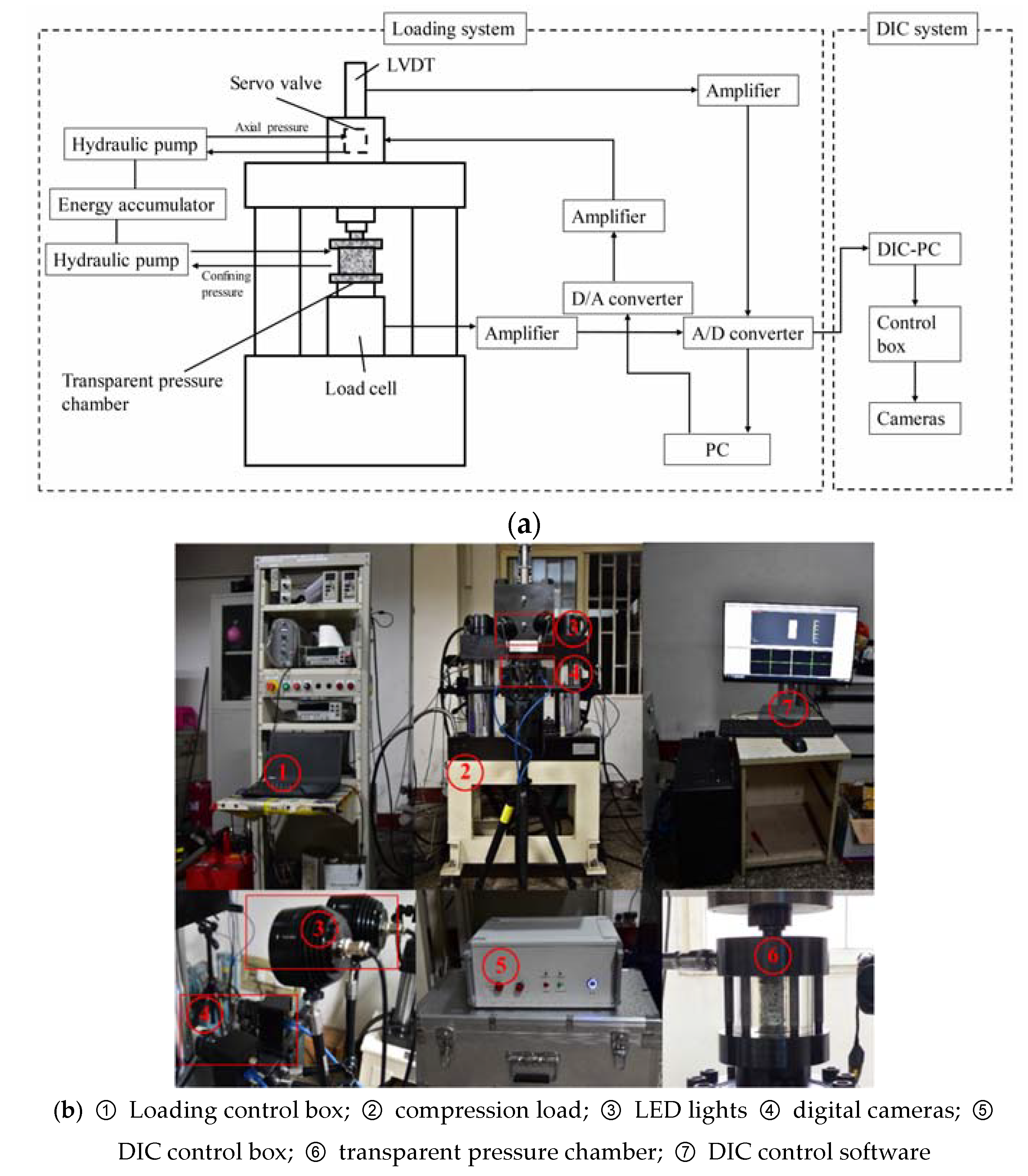
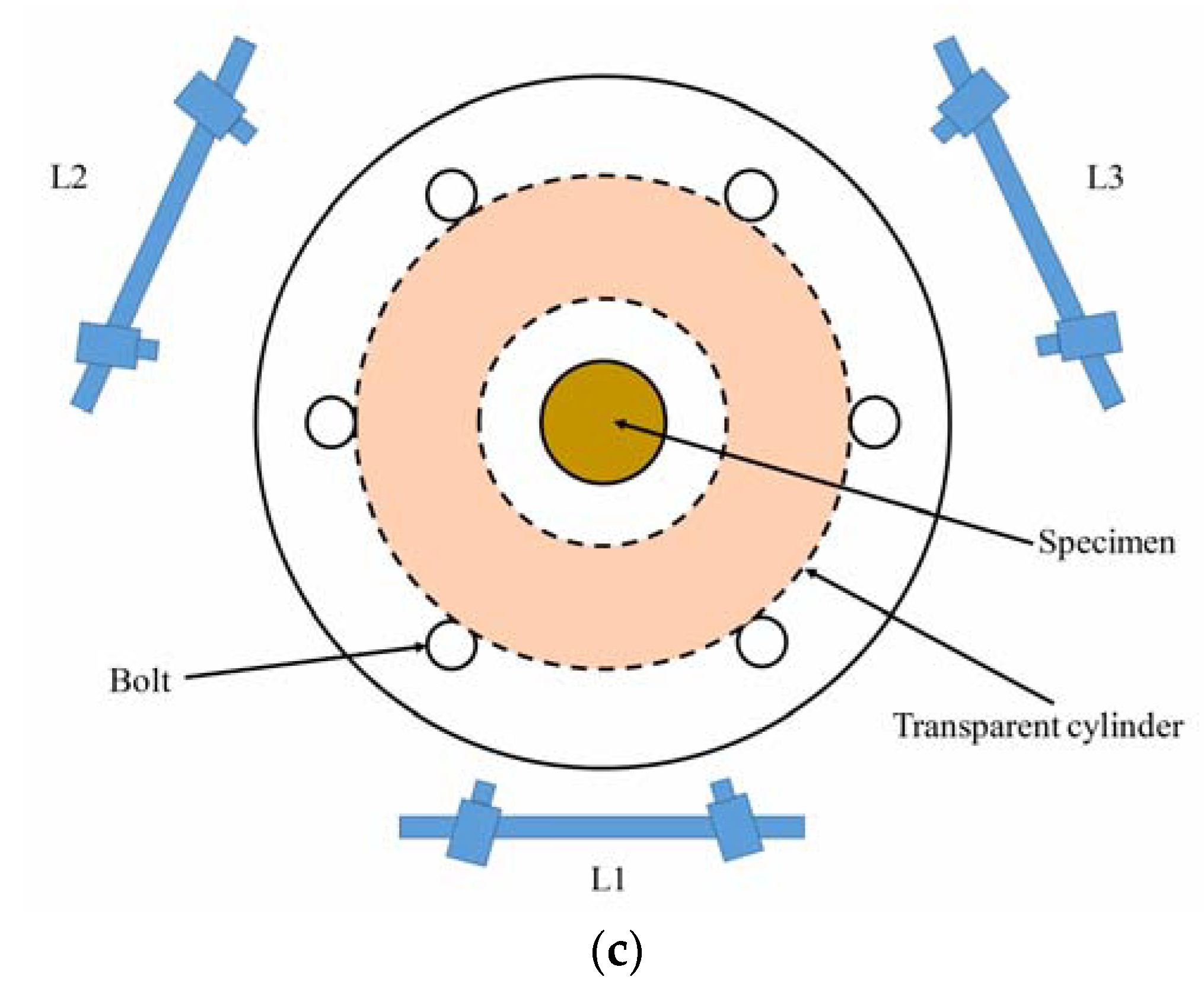
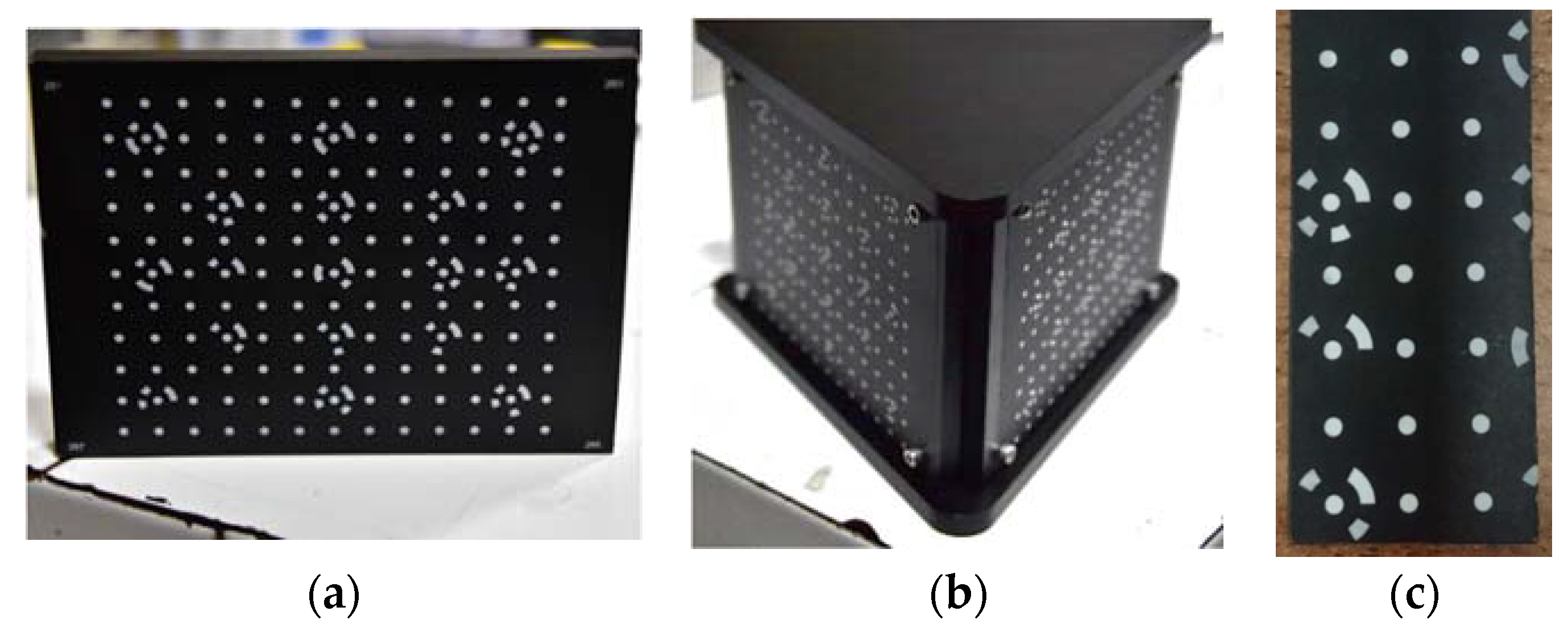

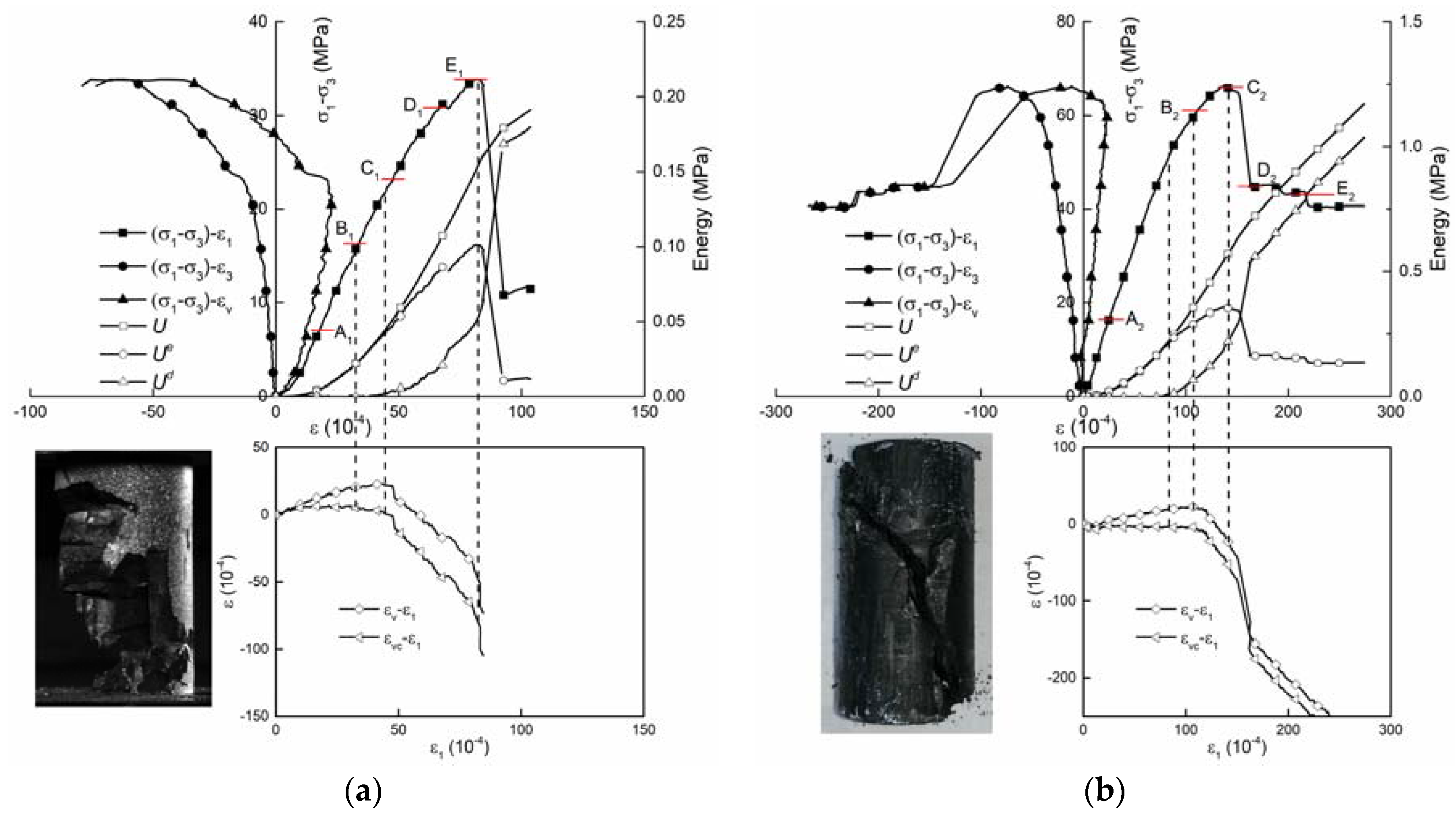
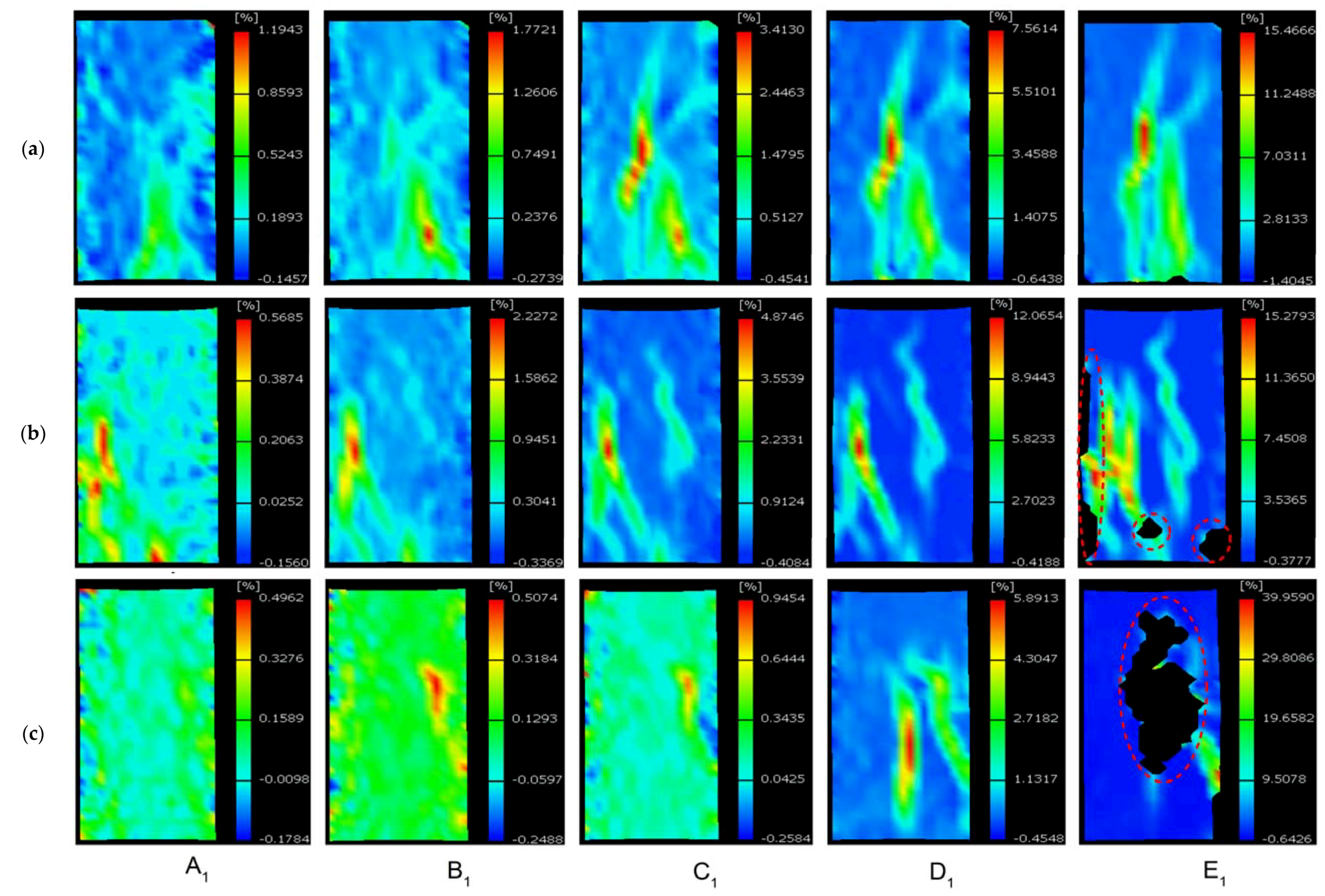
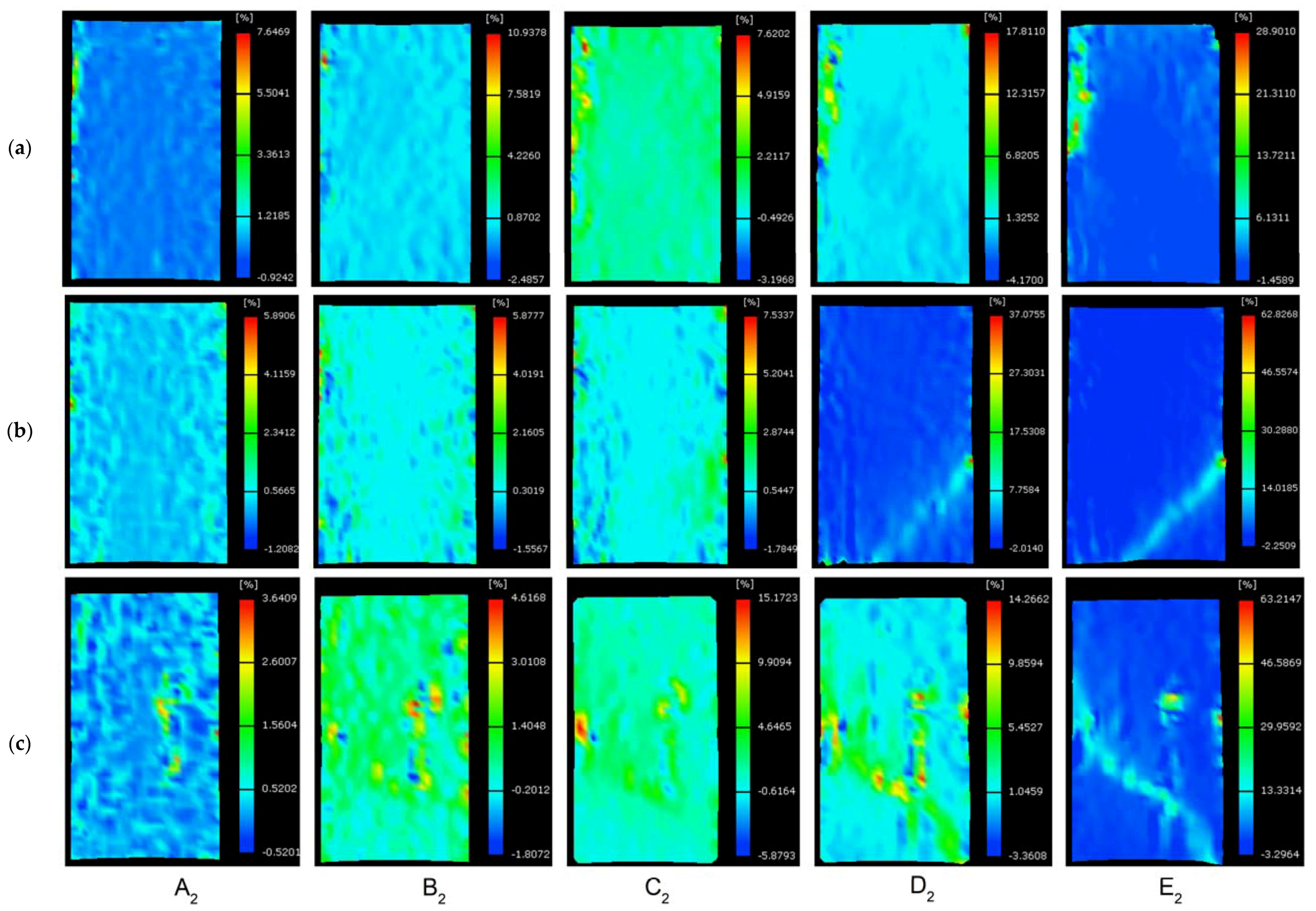
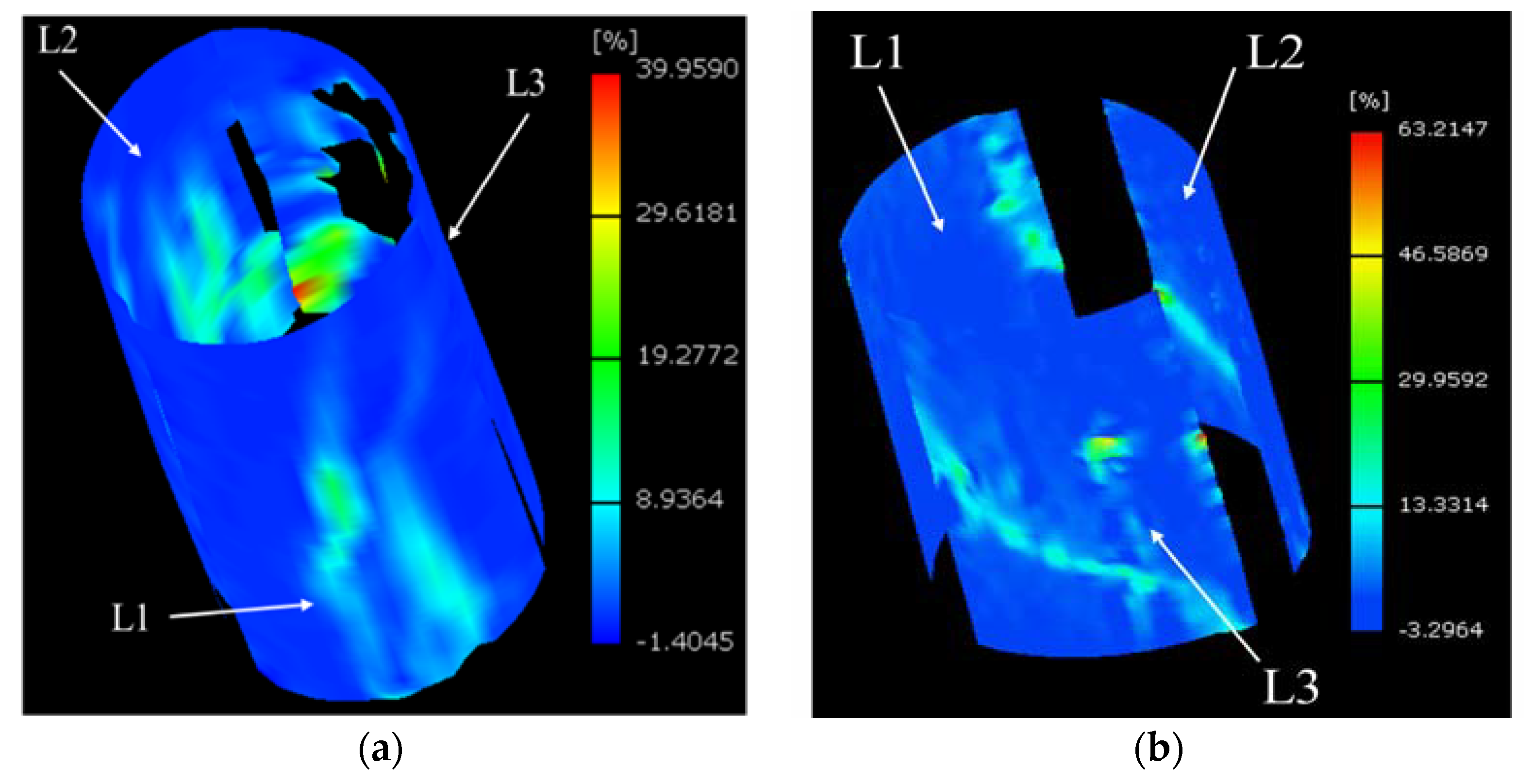
| Proximate Analysis (%) | Ro,max (%) | Coal Rank | |||
|---|---|---|---|---|---|
| Mad | Aad | Vad | FCad | ||
| 1.44 | 12.69 | 7.62 | 78.25 | 2.7 | anthracite |
| Test | E (GPa) | v | σci (MPa) | σcd (MPa) | σc (MPa) | σci/σc | σcd/σc |
|---|---|---|---|---|---|---|---|
| UC | 5.66 | 0.23 | 14.80 | 21.31 | 33.82 | 43.75% | 63.03% |
| TC | 6.14 | 0.36 | 49.38 | 59.51 | 66.25 | 74.53% | 89.84% |
© 2018 by the authors. Licensee MDPI, Basel, Switzerland. This article is an open access article distributed under the terms and conditions of the Creative Commons Attribution (CC BY) license (http://creativecommons.org/licenses/by/4.0/).
Share and Cite
Tang, Y.; Okubo, S.; Xu, J.; Peng, S. Study on the Progressive Failure Characteristics of Coal in Uniaxial and Triaxial Compression Conditions Using 3D-Digital Image Correlation. Energies 2018, 11, 1215. https://doi.org/10.3390/en11051215
Tang Y, Okubo S, Xu J, Peng S. Study on the Progressive Failure Characteristics of Coal in Uniaxial and Triaxial Compression Conditions Using 3D-Digital Image Correlation. Energies. 2018; 11(5):1215. https://doi.org/10.3390/en11051215
Chicago/Turabian StyleTang, Yang, Seisuke Okubo, Jiang Xu, and Shoujian Peng. 2018. "Study on the Progressive Failure Characteristics of Coal in Uniaxial and Triaxial Compression Conditions Using 3D-Digital Image Correlation" Energies 11, no. 5: 1215. https://doi.org/10.3390/en11051215




